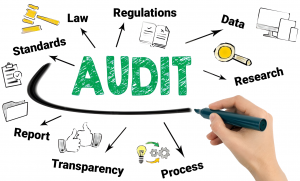Description
What is Internal Auditing?
Internal auditing can be described as a systematic, independent and documented process for obtaining evidence of conformity to a set of standards and the evaluation to determine the extent of compliance.
Audit evidence can be documentation, statements and records verifying the evidence. This may include physical items and visually observed evidence. An internal audit is undertaken by persons other than a 3rd party (e.g. not external AS/NZS ISO certification auditors).
An audit seeks to assure management that risks to the organization’s objectives are being (or will be) adequately managed and controlled. The audit findings can enable any required corrective actions to an AS/NZS ISO management system or processes to be communicated to the relevant parties.
A completed audit report should detail all of the audit results, documentation sighted and issues observed. This will enable the monitoring and reviewing of any corrective actions that were raised.
What is an Internal Auditing Procedure?
An internal auditing procedure documents the essential processes to be undertaken before, during and after an audit. The audit procedure will document the responsibilities, purpose and objectives of the audit. The general activities covered in an internal auditing procedure will include:

- How to prepare for the audit process.
- Selection of internal auditors and key personnel to perform the audit.
- Create an audit program.
- Preparing an audit plan.
- Audit committee and audit team duties.
- Conducting the audit.
- Audit observations.
- Data review and initial reporting.
- Audit internal control actions.
- Final written responses and reporting.
An auditing procedure will document how you can:
- Conduct system audits.
- Conduct process audits.
- Conduct supplier audits.
- Conduct legislation audits.
- Conduct the audit and internal audit functions.
- Develop corrective action plans.
- Plan for auditing annually.
- Complete the internal audit reports.
What is the Objective of an Internal Auditing Procedure?
The objective of an internal audit working procedure is to define a process for undertaking internal management system audits, process audits, supplier and legislation audits to assess the effectiveness of a management system and its compliance (as applicable) to:
- AS/NZS ISO 9001, Quality Management Systems – Requirements.
- AS/NZS ISO 14001, Environmental Management Systems – Requirements with Guidance for Use.
- AS/NZS ISO 45001, Occupational Health and Safety Management Systems –Requirements with Guidance for Use.
Who Should Perform an Internal Audit?
To ensure impartiality and objectivity internal (and external) auditors should be a person(s) from divisions of a workplace that is not directly associated with the area, process or department being audited.
In addition to the above, internal auditors should be selected based on their:
- Education
- Experience.
- Relevant training.
- Audit experience (demonstrable knowledge and skills).
How Does Internal Audit Add Value to an Organization?
By objectively auditing your organization’s management system, policies, processes and procedures and reviewing previous audits, you can determine if the business is performing to the expected standard and continually improve your business.
An audit can help you determine:
- Health, safety, quality and environmental compliance levels.
- Operational effectiveness.
- Business risks and opportunities.
- Business process compliance and controls.
- Process and operational efficiencies.
- Cost and waste reduction opportunities.
- Corporate governance compliance.
Contents of this Internal Audit Procedure
- Approval.
- Purpose.
- Scope and Objectives.
- Terms and Definitions.
- Roles and Responsibilities.
- Procedures.
- Auditing Process Overview.
- Auditing Process Flowchart.
- How to Prepare and Control the Internal Audit Process.
- Selecting Internal Auditors.
- Developing an Audit Program.
- Preparing for the Audit.
- Conducting the Audit.
- Data Review and Initial Reporting.
- Audit Actions.
- Final Reporting.
- Audit Reviews.
- Conducting Audits.
- System Audits.
- Process Audits.
- Supplier Audits.
- Legislation Audits.
- Corrective Actions.
- Completed Internal Audit Reports.
- Related Procedures, Forms and Documents.
- Review Criteria.
- Record Management.
- References.
Why Choose to Buy this Internal Auditing Procedure
This 10-page internal audit procedure can be applied to the auditing and assessment process of your business by following the principles of auditing that are outlined by AS/NZS ISO 19011, Guidelines for Auditing Management Systems.
The auditing procedure can enable your internal audits to be conducted with due professional care, integrity and independence.
This procedure can also assist you to comply with all the internal auditing requirements of:
- AS/NZS ISO 9001, Quality Management Systems – Requirements.
- AS/NZS ISO 14001, Environmental Management Systems – Requirements with Guidance for Use.
- AS/NZS ISO 45001, Occupational Health and Safety Management Systems -Requirements with Guidance for Use.
The procedure can assist internal audit teams, guided by an internal audit charter and adhering to international standards, and play a vital role in assessing both internal and external audits to ensure the organization’s risk management and control environment are sound.
Through the professional practice of internal auditing, aligned with the Institute of Internal Auditors’ guidelines, these auditors and audit teams can provide assurance to the board of directors on the effectiveness of governance processes and compliance audits.
After purchasing this internal auditing procedure you will be able to:
- Very easily edit and customize the template to create your own auditing procedure.
- Apply your own style, format and brand to the procedure.
- Use it in any industry or sector regardless of the size or type of organization.
Availability and Use of this Internal Auditing Procedure
- This internal auditing procedure is accessible to you right now by clicking the ‘Buy Now’ button.
- The procedure will be delivered to you in fully editable Microsoft Word format for immediate and full use in your business.
- There are no subscriptions, contracts or ongoing costs.

This internal auditing procedure is 100% satisfaction guaranteed.
You may also require:


